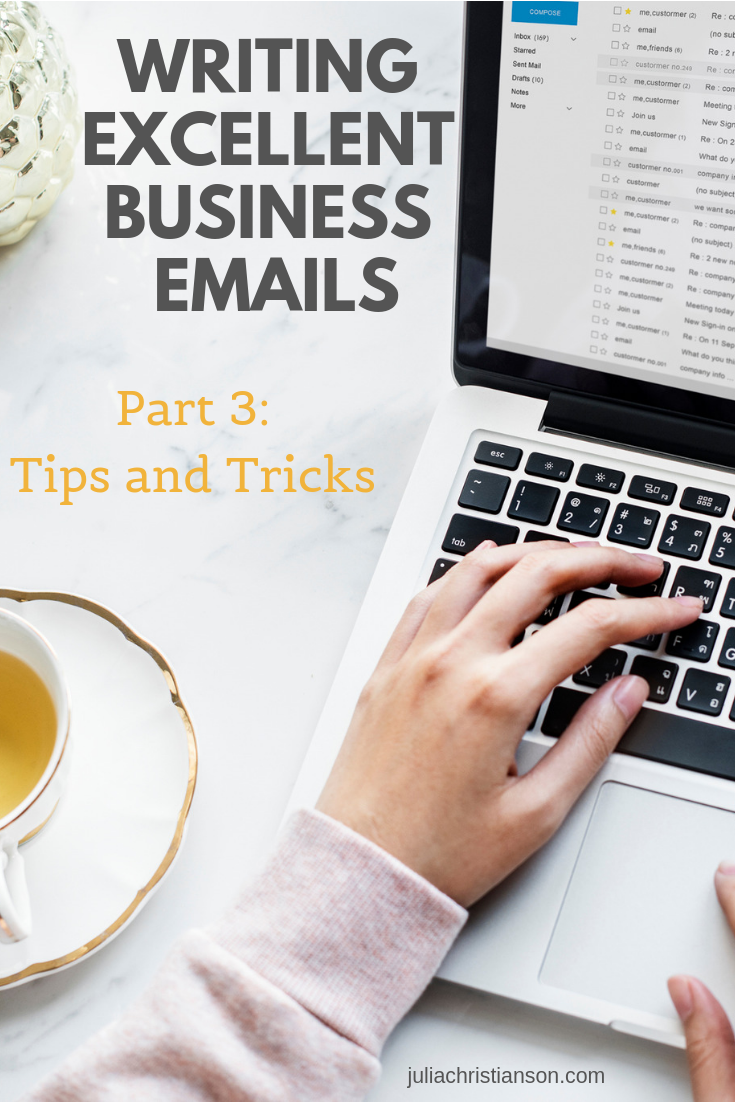
Writing excellent business emails will help you to remain more organized and focused in your work. When you have all your information straight, it’s easy to prevent misunderstandings and stay on top of business dealings so that things keep working smoothly. This part, part three, provides ten useful tips and tricks to make your emails better, and save you time in future exchanges.
Abbreviations
Avoid abbreviations unless absolutely necessary. They can be confusing and are easy to write incorrectly, which won’t be caught by a spell-checker (which don’t usually check all-caps words).
Attachments
Attachments are often a key part of business emails. To save time and frustration, when you make an attachment, write in the email that you did it and what the name and file extension of the attachment are to avoid confusion. Be sure to INCLUDE file type extensions! Some extensions don’t work on older or newer systems, and this will allow the recipient to let you know they need a different format. For example: “I have attached the latest presentation, Friday Presentation (fridaypresentation06.ppt). Please take a look and let me know if anything needs to be changed.”
Breaking up Paragraphs
Keep things concise. Add paragraph breaks at topic changes or after a you finish an idea to keep things clear. Five or six short paragraphs is preferable to one large one!
Emails Are Not Texts
Do NOT treat email as texting! You MUST have openings and closings! Don’t pepper people with brief, disorganized emails. Instead, collect all the information you have and what you need from the other person, and send a proper email if you need information. Otherwise, interoffice messaging programs, a phone call, or good old-fashioned in-person interaction is a better choice.
Keeping Emails
Keep past emails until an exchange is fully complete. When referring to past emails, copy-paste relevant info as necessary: “In your email on June 1, you said, ‘We need 36 units by Friday June 9’, and we sent those units on June 3. Please refer to attached shipping receipt (USPS receipt 20170603-01.pdf) for more information.”
Numbers
Be explicit and complete when giving dates, times, and numbers. Use a.m. and p.m. (especially important for international connections!) and write dates and days out completely (June 2, versus 06/07, which could be significantly confusing due to international standards) to ensure accurate communication.
Reply Versus Reply All
“Reply” should be used to respond to only the sender; “Reply All” should be used sparingly, and only when all parties, including CC’ed parties, need to see the response. It is better to hit “Reply” and add individuals to the CC field than it is to send emails to uninterested parties, or risk giving out sensitive information in search of saving a few seconds. Make “Reply” your default.
Respond Completely
When you are writing a response to an email, make sure you address all points brought up in the original email. Do this in the order they were given in the other email unless you have a compelling reason to reorder them.
Respond to Email with Email
If you get an email, make sure you reply by email! Unless the person explicitly asks you to call or text in reply, don’t! Business communication can get murky when multiple formats are used. To keep all information easily accessible and organized, respond in the format in which you were approached.
Be Professional
Above all, consider the kind of email YOU would like to receive. Does your email meet your associate’s needs? Are all questions answered, all numbers accurate, and the email sent in a timely way? Take time to reread for content and for the sake of proofreading—don’t send the email off-the-cuff! For important emails that are not urgent, write the email and save it as a draft, returning to read it half a day or a full day later before sending it. Seeing it with fresh eyes can make all the difference.
By sending excellent emails you will get better results for your business dealings and gain the respect of those you connect with for business. If you have any questions or thoughts, feel free to comment below, and share your tips and tricks for sending better business emails.
Writing Excellent Business Emails? is there any tips?
Please take a look in the post to see my top tips and tricks! Three important things for business emails: be professional; be concise; and give all the information in one place.